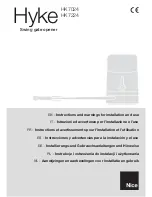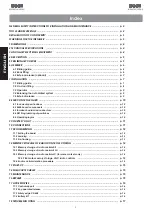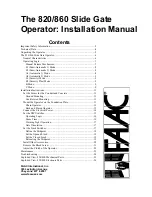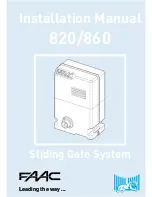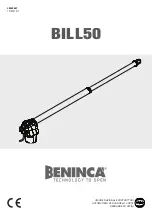
EN
4
– English
06.
Lastly, tighten the disk fixing nut fully down (
fig. 11-5
) to ensure that it does
not rotate accidentally.
3.6 - Manually releasing and locking the gearmotor
The gearmotor is equipped with a mechanical blocking system to enable man-
ual opening and closing of the gate.
These manual operations should only be performed in the event of a power fail-
ure, malfunctions or during the installation procedures.
Release
(
fig. 12-A
):
01.
Insert the key in the relative lock;
02.
Turn the key clockwise (90°);
03.
The lever comes out under action of a spring: turn the lever anti-clockwise
through 90°;
04.
At this point the leaf can be moved manually to the required position.
Lock
(
fig. 12-B
):
01.
Turn the lever through 90° to place the stem in a vertical position;
02.
Push the lever back into its seat;
03.
Turn the key anti-clockwise through 90° and remove.
The electrical connection of the various devices (photocells, digital keyboard,
transponder card readers, etc.) contained in the automation with the control
unit must be made by means of the Nice “Bluebus” system.
Description of electrical connections (fig. 13)
AERIAL
input for the radio receiver aerial
FLASH
output for 1 flashing light with 12V (maximum 21W) bulb. [
*
]
ELS
output for 12Vac (maximum 15VA) electric lock. [
*
]
S.C.A.
“Open Gate Light”: output for 1 indication lamp (24V maximum
4W). [
*
]
BLUEBUS
input for compatible devices (MOFB, MOFOB, MOB and MOTB);
they are connected in parallel using two conductors through which
both the electricity supply and the communication signals travel;
no polarity needs to be observed. The electrical connection to be
used is of the parallel type and no polarity needs to be observed.
During the learning stage, the control unit will recognise individually
all devices connected to it thanks to a unique code. Each time a
device is added or eliminated, it will be necessary to make the
control unit perform the learning operation (see paragraph 4.6).
STOP
input for devices that cause the immediate interruption of the
manoeuvre in progress (with a short reverse run); NO and NC
contacts, as well as devices with 8.2 k
Ω
constant resistance
output (sensitive edges) can be connected to this input. Each
device connected to this input is recognised individually by the
control unit during the learning stage (paragraph 3.4); in this stage,
if the control unit detects any variations with respect to the learned
state, it causes a STOP. One or more devices of the same or
different kinds can be connected to this input:
– connect a number of NO devices in parallel without quantity limits;
– several NC devices can be connected in series, with no limits as
to quantity;
– connect 2 devices with 8.2 k
Ω
constant resistance output in
parallel. If there are more than 2 devices, they must be connected in
a cascade with just one 8.2 k
Ω
termination resistance;
– connect 2 NO and NC devices in parallel, placing a 8.2 k
Ω
resistance in series on the NC contact (this also allows for a
combination of three devices NO - NC and 8.2 k
Ω
)
P.P.
input for devices which control Step-by-Step manoeuvres.
NO contacts can be connected to this input
OPEN
input for devices which control only opening manoeuvre.
NO contacts can be connected to this input
CLOSE
input for devices which control only closure manoeuvre. NO contacts
can be connected to this input
ENC1
input encoder – gearmotor 1 (terminal 1, 2); it is not necessary to
observe any polarity
ENC2
input encoder – gearmotor 2 (terminal 4, 5); it is not necessary to
observe any polarity
M1
output for gearmotor 1 (terminal 7, 8, 9)
M2
output for gearmotor 2 (terminal 10, 11, 12)
[
*
] The outputs FLASH, ELS and S.C.A. can be programmed with other func-
tions (see “TABLE 3 - Level 1 functions”; or via the Oview programmer; see
paragraph 8.3).
ELECTRICAL CONNECTIONS
4
4.1 - Electrical connections of gearmotor with control unit
mod. HK7024
Caution!
– Only make the electrical connections after installing the gear-
motor.
WARNINGS
– Connections must be made exclusively by qualified personnel.
– All electrical connections must be made with the unit disconnected
from the mains power supply and with the buffer battery disconnected (if
present).
–
The electrical power line must be fitted with a device that enables complete
disconnection of the automation from the mains. The disconnection device
must have a gap between contacts that ensures complete disconnection in the
conditions of overvoltage category III, in compliance with installation regula-
tions. If necessary, this device guarantees rapid and safe disconnection from
the mains, and therefore should be located in view of the automation. However,
if located in a concealed position, it must have a system that blocks against
inadvertent or unauthorised reconnection to prevent all risks. The disconnec-
tion device is not supplied with the product.
01.
Open the cover (
fig. 14-1
);
02.
Raise the control unit (
fig. 14-2
);
03.
Pass the power cable and other cables through one of the holes on the
lower section of the gearmotor; strip the sheath on the cable (
fig. 14-4
);
04.
Unscrew the cable clamp and route the power cable as required (
fig. 14-5
);
05.
First connect the power cable, see
fig. 14-6
;
06.
Secure the power cable with the cable clamp (
fig. 14-7)
;
07.
Then connect the electric cables of motors M1 and M2, observing the sym-
bols on the label (
fig. A
):
a)
connect the motor that activates the subordinate leaf (the second to
start the opening manoeuvre) to terminal M1 (7-8-9) and then the respec-
tive encoder to terminals 1-2;
b)
connect the motor that activates the main leaf (the first to start the open-
ing manoeuvre) to terminal M2 (10-11-12) and then the respective encoder
to terminals 4-5;
IMPORTANT!
– If there is only one gearmotor in the system, connect
it to terminal M2 leaving terminal M1 free;
08.
The connect the electric cables of the various devices present, with refer-
ence to
fig. 17
and paragraph 4.3
Note
– To facilitate cable connections,
the terminals can be removed from their seats;
09.
Close the cover of the gearmotor (
fig. 14-8
).
4.2 - Connection of gearmotor without control unit
mod. HK7224
01.
Open the cover as shown in
fig. 15-1
;
02.
Pass the motor cable through one of the holes on the lower section of the
gearmotor; strip the sheath on the cable (
fig. 15-2
);
03.
Unscrew the cable clamp (
fig. 15-3
), place the cable in the relative route
and connect the wires as shown in
fig. 16-4
; observe the symbols on the
label ;
03.
Secure the cable with the cable clamp (
fig. 15-5)
;
04.
Close the cover of the gearmotor (
fig. 15-6
).
4.3 - Connection of other devices
If further devices present in the system need to be powered, for example a
transponder card reader or the key selector light, these devices can be con-
nected to the control unit using terminals “P.P. (positive)” and “STOP (negative)”
(
fig. 13
). The power supply voltage is 24 Vdc, -30% ÷ +50%, with maximum
available current 200 mA.
Note
– The voltage present on terminals “P.P.” and “STOP” remains connected
even when the “Stand By” function is activated on the card.
4.4 - Routing connected devices
To enable control unit recognition of the devices connected to the BlueBus sys-
tem, they need to be routed. This operation must be performed by positioning
the electric jumper correctly on each device: see
fig. B
.
To route other devices, consult the relative instruction manuals.
At the end of the installation procedure, or after removing photocells or other
devices, the device learning procedure must be performed as described in
paragraph 4.6.
ENC1
ENC2
1
2
4
5
7
8
9
10
11
12
M1
M2
24V
24V
+
-
+
-
A
Summary of Contents for HK7024
Page 2: ......
Page 25: ...IX 1 2 3 4 320 mm 210 mm 290 mm ...
Page 27: ...XI 1 2 a b 3 9 5 OK OK b a 9 b a a b x 4 c a 4 1 2 3 4 90 90 10 7 6 8 ...
Page 28: ...XII 9 1 2 a b 3 10 5 b x 4 c a 4 8 b a 10 1 2 3 13 11 6 OK OK 7 ...
Page 29: ...XIII 1 2 90 3 90 12 A 90 2 1 3 12 B 4 OK 3 NO 2 NO 11 1 3 2 5 4 ...
Page 31: ...6 1 2 8 7 15 1 3 5 1 2 2 4 XV ...
Page 32: ...XVI 16 1 2 7 6 17 L1 OPEN STOP CLOSE L2 L3 L4 L5 L6 L7 L8 ...
Page 33: ...XVII 1 2 1 2 18 1 3 5 1 2 2 2 1 4 19 1 2 ...
Page 34: ...XVIII 1 2 20 1 4 1 2 3 2 ...

